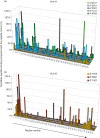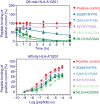Extensive major histocompatibility complex class I binding promiscuity for Mycobacterium tuberculosis TB10.4 peptides and immune dominance of human leucocyte antigen (HLA)-B*0702 and HLA-B*0801 alleles in TB10.4 CD8 T-cell responses
- PMID: 20002212
- PMCID: PMC2842496
- DOI: 10.1111/j.1365-2567.2009.03201.x
Extensive major histocompatibility complex class I binding promiscuity for Mycobacterium tuberculosis TB10.4 peptides and immune dominance of human leucocyte antigen (HLA)-B*0702 and HLA-B*0801 alleles in TB10.4 CD8 T-cell responses
Abstract
The molecular definition of major histocompatibility complex (MHC) class I-presented CD8(+) T-cell epitopes from clinically relevant Mycobacterium tuberculosis (Mtb) target proteins will aid in the rational design of T-cell-based diagnostics of tuberculosis (TB) and the measurement of TB vaccine-take. We used an epitope discovery system, based on recombinant MHC class I molecules that cover the most frequent Caucasian alleles [human leucocyte antigen (HLA)-A*0101, A*0201, A*0301, A*1101, A*2402, B*0702, B*0801 and B*1501], to identify MHC class I-binding peptides from overlapping 9-mer peptides representing the Mtb protein TB10.4. A total of 33 MHC class I-binding epitopes were identified, spread across the entire amino acid sequence, with some clustering at the N- and C-termini of the protein. Binding of individual peptides or closely related peptide species to different MHC class I alleles was frequently observed. For instance, the common motif of xIMYNYPAMx bound to six of eight alleles. Affinity (50% effective dose) and off-rate (half life) analysis of candidate Mtb peptides will help to define the conditions for CD8(+) T-cell interaction with their nominal MHC class I-peptide ligands. Subsequent construction of tetramers allowed us to confirm the recognition of some of the epitopes by CD8(+) T cells from patients with active pulmonary TB. HLA-B alleles served as the dominant MHC class I restricting molecules for anti-Mtb TB10.4-specific CD8(+) T-cell responses measured in CD8(+) T cells from patients with pulmonary TB.
Figures



Similar articles
-
Impact of MHC class I alleles on the M. tuberculosis antigen-specific CD8+ T-cell response in patients with pulmonary tuberculosis.Genes Immun. 2007 Jun;8(4):334-43. doi: 10.1038/sj.gene.6364392. Epub 2007 Apr 12. Genes Immun. 2007. PMID: 17429413
-
Human leukocyte antigens A*3001 and A*3002 show distinct peptide-binding patterns of the Mycobacterium tuberculosis protein TB10.4: consequences for immune recognition.Clin Vaccine Immunol. 2011 Jan;18(1):125-34. doi: 10.1128/CVI.00302-10. Epub 2010 Nov 17. Clin Vaccine Immunol. 2011. PMID: 21084459 Free PMC article.
-
A broad profile of co-dominant epitopes shapes the peripheral Mycobacterium tuberculosis specific CD8+ T-cell immune response in South African patients with active tuberculosis.PLoS One. 2013;8(3):e58309. doi: 10.1371/journal.pone.0058309. Epub 2013 Mar 26. PLoS One. 2013. PMID: 23555576 Free PMC article. Clinical Trial.
-
Genome wide approaches discover novel Mycobacterium tuberculosis antigens as correlates of infection, disease, immunity and targets for vaccination.Semin Immunol. 2018 Oct;39:88-101. doi: 10.1016/j.smim.2018.07.001. Epub 2018 Jul 7. Semin Immunol. 2018. PMID: 30327124 Review.
-
[MHC tetramers: tracking specific immunity].Acta Med Croatica. 2003;57(4):255-9. Acta Med Croatica. 2003. PMID: 14639858 Review. Croatian.
Cited by
-
The polyomavirus BK large T-antigen-derived peptide elicits an HLA-DR promiscuous and polyfunctional CD4+ T-cell response.Clin Vaccine Immunol. 2011 May;18(5):815-24. doi: 10.1128/CVI.00487-10. Epub 2011 Mar 2. Clin Vaccine Immunol. 2011. PMID: 21367979 Free PMC article.
-
Orchestration of pulmonary T cell immunity during Mycobacterium tuberculosis infection: immunity interruptus.Semin Immunol. 2014 Dec;26(6):559-77. doi: 10.1016/j.smim.2014.09.003. Epub 2014 Oct 11. Semin Immunol. 2014. PMID: 25311810 Free PMC article. Review.
-
Insights into HLA-restricted T cell responses in a novel mouse model of dengue virus infection point toward new implications for vaccine design.J Immunol. 2011 Oct 15;187(8):4268-79. doi: 10.4049/jimmunol.1101970. Epub 2011 Sep 14. J Immunol. 2011. PMID: 21918184 Free PMC article.
-
Mycobacterium tuberculosis peptide E7/HLA-DRB1 tetramers with different HLA-DR alleles bound CD4+ T cells might share identical CDR3 region.Sci Rep. 2018 Jul 2;8(1):9903. doi: 10.1038/s41598-018-28344-7. Sci Rep. 2018. PMID: 29967390 Free PMC article.
-
Function and Potentials of M. tuberculosis Epitopes.Front Immunol. 2014 Mar 24;5:107. doi: 10.3389/fimmu.2014.00107. eCollection 2014. Front Immunol. 2014. PMID: 24715888 Free PMC article. Review.
References
-
- Flynn JL, Chan J. Immunology of tuberculosis. Annu Rev Immunol. 2001;19:93–129. - PubMed
-
- Lazarevic V, Flynn J. CD8+ T cells in tuberculosis. Am J Respir Crit Care Med. 2002;166:1116–21. - PubMed
-
- Dietrich J, Weldingh K, Andersen P. Prospects for a novel vaccine against tuberculosis. Vet Microbiol. 2006;112:163–9. - PubMed
-
- Wu LC, Tuot DS, Lyons DS, Garcia KC, Davis MM. Two-step binding mechanism for T-cell receptor recognition of peptide MHC. Nature. 2002;418:552–6. - PubMed
Publication types
MeSH terms
Substances
LinkOut - more resources
Full Text Sources
Other Literature Sources
Research Materials
Miscellaneous

